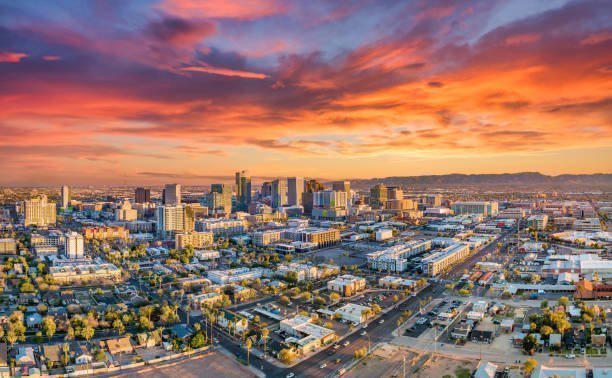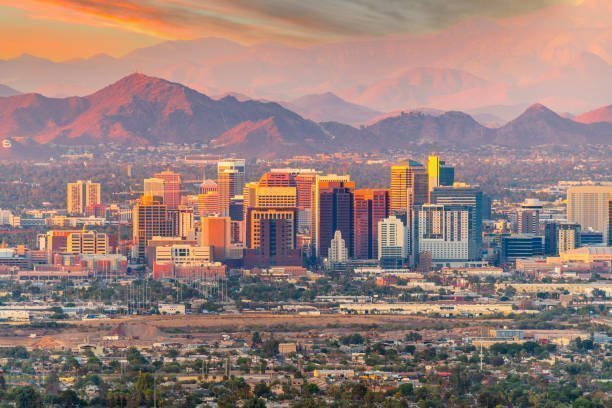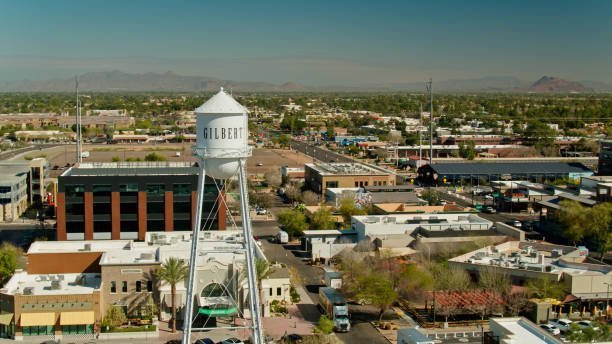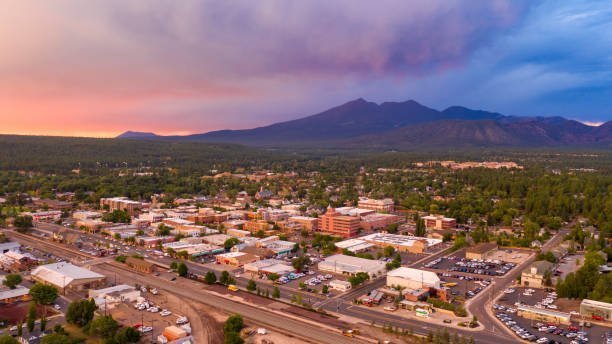Before you head out with your drone to explore the beautiful scenery in your city, you have to be aware of the drone laws in Arizona else you risk getting into trouble with the law.
Are drones allowed in Arizona?
Flying a drone is legal in the state of Alaska. However, it has federal, state, and local laws that govern the flying of drones in the state. The state laws regulate drone operators from flying near manned aircraft, while the local laws limit the parks and cities where you can fly a drone in the state.
In this article, I will cover everything you need to know about Arizona drone laws for you to enjoy a pleasurable flight with your drone and stay clear of any legal proceedings.
Federal Drone Laws In Arizona
The United States drone laws are the federal drone laws in Arizona and every state in the United States of America which was created by the federal government.
If you have a small drone that is less than 55 pounds, you can fly recreationally by following the Drone Laws in the USA as defined by FAA Part 107 guidelines.
Federal Drone Laws for Recreational Flying in Arizona

You can fly your drone for recreational purposes in Arizona as a hobby without seeking monetary compensation as long as you follow the FAA law (Part 107) and also check the state jurisdiction for additional licensing, permission, and clearance requirements.
Below are the federal rules to follow while flying your drone for recreational purposes in Arizona to keep you, your drone, and everyone safe in the airspace.
- Fly your drone only for recreational use or as a hobby.
- Follow the safety guidelines of an FAA-recognized Community Based Organization (CBO). Recreational flyers should follow the safety guidelines of existing aeromodelling organizations or use the FAA-provided safety guidelines per Advisory Circular 91-57B.
- Keep your drone within your visual line of sight or use a co-located visual observer (physically next to) and in direct communication with you.
- Don’t fly close or interfere with a manned aircraft.
- Fly below 400 feet in controlled airspace (Class B, C, D, and E) after obtaining permission from LAANC or FAA Drone Zone.
- Fly below 400 feet in uncontrolled airspace (Class G). Note: You can also be prohibited from flying in a Class G airspace in areas designated as prohibited areas, restricted areas, military operated areas, alert areas, etc. except given prior authorization from the FAA.
- Take The Recreational UAS Safety Test (TRUST) and carry proof of test passage.
- Always slap your registration number on the exterior surface of your drones and always carry the proof of registration with you. As a recreational flier, you are exempted from registering and marking your drones by the FAA as long as your drone weighs less than 0.55 lbs (250 grams).
- Do not dangerously operate your drone. For example:
- Do not interfere with emergency response or law enforcement activities.
- Do not fly under the influence of drugs or alcohol.
- Avoid flying near or over critical infrastructure.
You should be aware that you could be liable for civil and/or criminal penalties if you intentionally break any of these rules and regulations listed above as a recreational drone pilot.
As a recreational drone pilot, you are obliged to learn the rules and regulations put in place by the Federal Aviation Administration (FAA) on the proper use of drones for recreational flying.
You should also apply common sense when operating your drone in crowded public places, historic resources, and public places to keep everyone safe.
Federal Drone Laws For Commercial Drone flying in Alaska

You can fly your drone for commercial purposes in Arizona with the aim of seeking monetary compensation as long as you follow the FAA law (Part 107) and also check the state jurisdiction for additional licensing, permission, and clearance requirements.
Below are the federal rules to follow while flying your drone for recreational purposes in Alaska to keep you, your drone, and everyone safe in the airspace.
Step 1: Learn the Rules
- Read and understand the dos and don’ts as a commercial flyer the under Part 107 rules. Review a summary of the Part 107 rules (PDF). Still unsure if Part 107 rules work for you and your intended UAS operation? Check the FAA user identification tool.
- You can obtain a waiver to exceed some limit put in place by the FAA that is not covered by Part 107. Below are some laws in Part 107 that are subject to a waiver.
- Operation from a moving vehicle or aircraft. *
- Always operate your drone during the day. *
- Keep your drone from out of the Visual line of sight from an aircraft operation *
- Keep your drone in your Visual line of sight. *
- Operation of multiple small unmanned aircraft systems. *
- Yielding the right of way. *
- Don’t fly your drone over people. *
- Restriction from certain airspace. *
- Operating limitations for small unmanned aircraft.
- *The FAA will not waive this section to allow the carriage of property of another by aircraft for compensation or hire.
- You should read about the Part 107 Waiver application process if your drone operation requires a waiver.
- Commercial drone operators should steer clear of flying close to airports as it might be challenging for human aircraft to spot and avoid a drone in flight. Keep in mind that the UAV operator is accountable for any safety threat their drone poses in an airport area and must avoid crewed aircraft. Read more about flying near airports.
Step 2: Become an FAA-Certified Drone Pilot by Passing the Knowledge Test
- To be eligible to get your Drone License (Remote Pilot Certificate), you must be:
- At least 16 years old
- Able to read, write, speak, and understand English
- Be in a physical and mental condition to safely fly a UAS
- Review the entire process to get your Drone License or Remote Pilot Certificate.
- Study for the Knowledge Test by reviewing the Test Prep materials provided by the FAA.
- Obtain an FAA Tracking Number (FTN) by creating an Integrated Airman Certification and Rating Application (IACRA) profile before registering for a knowledge test.
- Schedule an appointment to take the Knowledge Test at an FAA-approved Knowledge Testing Center.
- Once you’ve passed your test, complete FAA Form 8710-13 for a remote pilot certificate (FAA Airman Certificate and/or Rating Application) using the electronic FAA Integrated Airman Certificate and/or Rating Application system (IACRA)*
- You are now eligible to operate as a commercial drone pilot.
Step 3: Register your drone with the FAA
- Pay the registration fee of $5 with your credit card or debit card to get a valid three year license to commercially fly drones.
- Visit dronezone.faa.gov and select “Fly sUAS under Part 107” to create an account and register your drone.
- After that, mark the exterior surface of your drone (PDF) with your registration number for identification and tracking if it were to get stolen
Always be sure to fly your drone safely and within FAA guidelines and regulations. It is up to you as a drone pilot to know the rules of the sky and where it is safe to fly. You should try the user identification tool if you aren’t sure if Part 107 is right for you and your operation
Federal Drone Laws for Public Drone Flying

Federal drone laws are drone laws for federal, state, local, or tribal government entities, including schools and universities that use unmanned aircraft systems or drone technology for their operations.
Federal Restrictions & Requirements
- Be a political subdivision of the United States government, a State or U.S. territory government, the District of Columbia, or an Indian Tribal Government listed in the Robert T Stafford Disaster Relief and Emergency Assistance Act (42 U.S.C. § 5122)
- Own and operate the unmanned aircraft, or for non-federal public aircraft operators (PAO’s) have an exclusive lease on it for more than 90 days
- Fly missions that meet the statutory criteria of a governmental function on a flight-by-flight basis
- Not fly for a commercial purpose or receive compensation for flight operations.
Emergency Situations
First responders and other organizations responding to natural disasters or other emergency situations may be eligible for expedited approval through our Special Governmental Interest (SGI) process. Operations that may be considered include:
- Firefighting
- Search and Rescue
- Law Enforcement
- Utility or Other Critical Infrastructure Restoration
- Incident Awareness and Analysis
- Damage Assessments Supporting Disaster Recovery Related Insurance Claims
- Media Coverage Providing Crucial Information to the Public
To apply for a waiver through the SGI process, you must be an existing Part 107 Remote Pilot with a current certificate OR you must have an existing Certificate of Waiver or Authorization (COA). To submit a waiver through this process, fill out the Emergency Operation Request Form and send to the FAA’s System Operations Support Center (SOSC) at 9-ator-hq-sosc@faa.gov .
If approved, the FAA will add an amendment to your existing COA or Remote Pilot Certificate that authorizes you to fly under certain conditions for the specified operation. If denied, operators should NOT fly outside the provisions of their existing COA or part 107. Operators have the option to amend their requests.
* This process is called the Special Government Interest (SGI) amendment process and is outlined in FAA Order JO 7200.23A
State Drone Laws In Arizona

The Arizona state drone laws are the drone laws that apply to the entire state of Arizona and were created by the Arizona State Legislature.
Arizona has one state-wide law concerning the use of drones in the state, as given by the Arizona Department of Transportation and the Arizona State Legislature.
Senate Bill 1449 (2016)
According to the state legislature and Department of Transportation, SB 1449 is presently the sole state-wide statute governing the use of drones and other UAV’s in Arizona. It adds Section 13-3729, which relates to unmanned aircraft, to Section 13-2904 of the Arizona Revised Statutes.
The following is a list of some of SB 1449’s key points:
- It is prohibited for a UAS to operate in a way that might jeopardize someone else’s life or property, interfere with rescue efforts in the event of a fire, interfere with other manned aircraft operations, or interfere with law enforcement.
- Unless prior written approval has been obtained, UAS may not fly closer than 500 feet horizontally or 250 feet vertically to a critical facility’s physical border.
- UAS are not permitted to fly over or hover close to a critical facility with the intention of taking pictures.
- Disorderly conduct is defined as flying a drone in “dangerous proximity” to a person or piece of property.
- In the state of Arizona, cities and municipalities with several parks must permit drones in at least one of them.
- It prevents the adoption of any ordinance, policy, or regulation that restricts the possession or operation of an unmanned aircraft by any city, town, or county in Arizona. Public UAS owned by the city, town, or county are exempt from this.
- A requirement in the statute calls for the Department of Transportation to keep an eye on FAA rules regarding unmanned aircraft systems in order to potentially repeal state laws. However, as of December 31, 2019, this provision is no longer in effect.
Terms Used In The Arizona Drone Laws
1. “Civil unmanned aircraft” means an unmanned aircraft or unmanned aircraft system that is operated by a person for any purpose other than strictly for hobby or recreational purposes, including commercial purposes, or in furtherance of or incidental to any business or media service or agency.
2. “Commercial purposes” means the use of an unmanned aircraft in return for financial compensation and includes aerial photography, aerial mapping, or geospatial imaging.
3. “Critical facility” means any of the following:
(a) A petroleum or alumina refinery.
(b) A petroleum, chemical or rubber production, transportation, storage or processing facility.
(c) A chemical manufacturing facility.
(d) A water or wastewater treatment facility and water development, distribution or conveyance system, including a dam.
(e) An electric generation facility, as defined in section 42-14156, and any associated substation or switchyard.
(f) An electrical transmission or distribution substation.
(g) An electrical transmission line of at least sixty-nine thousand volts.
(h) An electronic communication station or tower.
(i) An energy control center.
(j) A distribution operating center.
(k) A facility that transfers or distributes natural gas, including a compressor station, regulator station, city gate station or pressure limiting station or a liquefied natural gas facility or supplier tap facility.
(l) Any railroad infrastructure or facility.
(m) A federal, state, county or municipal court.
(n) A public safety or emergency operation facility.
(o) A federal, state, county or municipal jail or prison or other facility in which persons are incarcerated.
(p) A federal or state military installation or facility.
(q) A hospital that receives air ambulance services.
4. “Model aircraft” has the same meaning prescribed in section 336 of the FAA modernization and reform act of 2012 (P.L. 112-95), as amended.
5. “Person” means a corporation, firm, partnership, association, individual, organization, or any other group acting as a unit.
6. “Public unmanned aircraft” means an unmanned aircraft or unmanned aircraft system that is operated by a public agency for a government-related purpose.
7. “Unmanned aircraft” means an aircraft, including an aircraft commonly known as a drone, that is operated without the possibility of direct human intervention from within or on the aircraft.
8. “Unmanned aircraft system” means an unmanned aircraft and associated elements, including any communication links and components that control the unmanned aircraft.
Local Drone Laws In Arizona

The local drone laws in Arizona are the drone laws that apply only to certain regions, cities, or counties within the state of Arizona and were created by various authorities within the state.
City of Phoenix Drone Laws
All drone activities are prohibited by city ordinance in Phoenix public parks, with the exception of those that the Director has authorized. Acceptable operating locations must have a minimum of 400 feet of clear area without any obstructions such as trees, buildings, or fences that are ten feet or higher.
On the official Phoenix government page, you can find a list of eight parks that welcome drones:
- Coyote Basin
- Desert Foothills Park – Lower Field
- Dynamite Park
- El Prado Park
- Esteban Park – East Quadrant
- Grovers Basin
- Mountain View II Park – South of Ballfield
- Werner’s Field
The AMA Safety Code must be followed for all UAS activities conducted inside specified operation locations.
City of Scottsdale Drone Laws
The city ordinance defines the following places as being off-limits for UAS takeoff or landing:
- McDowell Sonoran Preserve
- Pinnacle Peak Park and Trailhead
- Mescal Park
- Stonegate Park
- Westworld
- McCormick-Stillman Railroad Park
Additional restricted sites are also listed on the Scottsdale government’s official website, which includes:
- Cactus Aquatic Center
- Chaparral Aquatic Center
- Eldorado Aquatic Center
- McDowell Mountain Ranch Aquatic Center

Town of Paradise Valley Drone Laws
According to a news release from 2015, commercial UAV activities must be registered with the Town at least four hours before they begin. However, Paradise Valley property owners are allowed to fly UAVs for fun at a height of no more than 500 feet on their own land. Trespassing is defined as flying over someone else’s private property without getting their permission.
City of Mesa Drone Laws
All parks and facilities owned and operated by the Mesa city are drone-free zones, with Basin 114 being the lone exception. Drop-on usage of the allocated space is only permitted on a first-come, first-served basis. Every operator needs a current AMA membership card. In order to fly an airplane, you must have insurance.
Maricopa County Drone Laws
According to Maricopa County park regulations, using engine-powered models and/or toys in any park must be done so in a way that doesn’t endanger the general public.
Town of Prescott Valley Drone Laws
The city’s drone ordinance specifies authorized usage and approved operations for search and rescue, law enforcement, and emergency management personnel.
City of Tempe Drone Laws
The Tempe Beach Park, Rio Salado Park, Papago Park (Tempe part), and city preserves are off-limits for UAS launches and landings according to local code.CONCLUSION
Arizona has good scenery to explore with your drone for recreational or commercial purposes. However, you need to stick with the drone rules and regulations to enjoy a peaceful exploration.
You should also check out the best places to fly a drone in Arizona if you need a beautiful and legal place to fly your drone in your city.
Frequently Asked Questions on Arizona Drone Laws
Is it illegal to fly a drone over private property in Arizona?
It is legal to fly drones above a house or private property in Arizona as long as you don’t hover around them or use your drone to capture or record them without permission from the property owner
Can I fly a drone in Arizona without a license?
Recreational drone pilots don’t need a license to fly a drone in Arizona, but you must pass a free online safety test (TRUST). However, commercial drone flyers must get a certificate (Part 107) from the FAA. Furthermore, all drones weighing more than 249 grams must be registered to operate in Arizona.
Can you shoot down a drone in Arizona?
Shooting down a drone in Indiana is illegal and against federal law because drones are protected by the FAA. You could serve some jail time or pay a large fine if you shoot down a drone in Indiana. You are advised to report it to the authorities if you see a drone hovering above you or your property.
Final Thoughts
Arizona has natural landscapes you can explore with your drone for recreational or commercial purposes. However, you need to abide by the drone laws set by the FAA, your state government, and local authorities in that city to enjoy a hassle-free flight.
You should also check out the best places to fly a drone in Arizona if you want to see beautiful places that are legal to fly in various cities.

